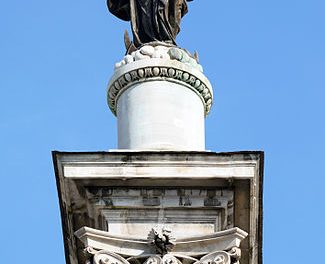Revelation 7:2-4, 9-14
Psalm 24
I John 3:1-3
Matthew 5:1-12
One of the most stirring lines left behind by Carl Sagan, the famous public advocate of science and host of the original Cosmos series, was that “we are made of star stuff.” The matter from which the world as we know it is made is the product of the unimaginable energy released within the centers of collapsing stars billions upon billions of years ago. It would have been striking enough had Sagan left the matter there, but on several occasions he took it even further, suggesting that the “star stuff” in us draws us outward to the “star stuff” in the wider cosmos:
The surface of the Earth is the shore of the cosmic ocean. On this shore, we’ve learned most of what we know. Recently, we’ve waded a little way out, maybe ankle-deep, and the water seems inviting. Some part of our being knows this is where we came from. We long to return, and we can, because the cosmos is also within us.… We are a way for the cosmos to know itself.
To be sure, there is more than a slight trace of pantheism in the cosmic perspective of Carl Sagan. It is clear that for him, there is no transcendent realm nor any intelligent origin of the cosmos considered as a whole. Yet there is nevertheless a valuable lesson Christians can take from his observation that “we are made of star stuff.”
Genesis makes the bold yet fundamental claim that human beings are made “in the image and likeness” of the one Creator God. From our very origin as a species, we bear some resemblance to the transcendent source of all things. In the human person may be found not only the vestige of the divine artistry which marks all created things, but the very image of the Artist himself: in the vast gallery of divine masterworks, we are the living self-portrait and for that reason the crowning achievement.
This direct resemblance to God is an indelible attribute of our nature but also a perpetual calling. We are like God, and yet we are also called to be “perfect even as [our] heavenly Father is perfect.” In this resemblance, which is irrevocable and yet always imperfectly realized, may be found the entire drama of human life— the “universal call to holiness.” Put another way, our task in this world is as simple as it is daunting: to be saints. “There is only one tragedy in the end,” wrote Leon Bloy, “not to have been a saint.”
To be a saint should be our number one life-goal, taking priority over everything else. And yet how ridiculous that seems, how almost megalomaniacal! A serious desire for sainthood cannot but be confused in our own day with an ambition for lasting fame. It could also be regarded as a misguided desire for esteem among the pious, to be a symbol for the spiritual status quo. That is why Dorothy Day purportedly remarked that she did not want to be regarded as a saint, since she “did want to be dismissed that easily.”
On the one hand, we should readily admit that the saints proclaimed in every age by the Church are, at least in some respect, extraordinary individuals. On the other hand, however, it is important to remember that we are made in the same image as they are. And each of us has the same calling as they did, even if ours ultimately looks different from theirs, not to mention from each other’s. In his Apocalyspe, John speaks of his vision of “a great multitude, which no one could count, from every nation, race, people, and tongue” standing before the throne of the Lamb in the heavenly liturgy. “These are the ones who have survived the time of great distress; they have washed their robes and made them white in the Blood of the Lamb.” John is surely referring to the martyrs here, but we would perhaps not be amiss in seeing in them also the fundamental form of every individual life that conforms itself to Christ: we are all called to “take up our cross” and follow Jesus’ footsteps, to “die to ourselves” and live the life of the resurrected One who dwells within us.
Too often when we reflect on the saints, we are tempted to think that a comprehensive transformation lies between their lives and ours, between their way of thinking and acting and ours. Yet for the baptized, the comprehensive transformation has already taken place. We are faced with the Church’s bold claim that in our baptism we have died and risen again, and that we are now truly conformed to Christ. We share in His nature, and thus truly participate (to whatever degree we realize it) in the divine life of the triune God. But again—how hard it is to accept this reality! We are God’s children! Bearers of the divine Spirit! Heirs and princes in the Kingdom of God! Perhaps we can understand St. John’s apparent wonder at this reality, and his pause to reiterate it: “See what love the Father has bestowed on us that we may be called the children of God. Yet so we are.”
Scott Hahn has remarked how much of the struggle of the Christian life is packed into these four words: “yet so we are.” It is one thing to think it, even to affirm it; yet it is another thing entirely truly to believe it and live it. That is what it means to be a saint: to be a child and to know and claim whose child you are. For children carry their parents inside them, and they often cannot help but act like them. Yet the child who loves also desires to be like the parent, and so the child of God seeks to be like Him. And how? What does the child of God look like in the world?
The Son Himself, the very Image of the Father, answers with these words:
Blessed are the poor in spirit,
for theirs is the Kingdom of heaven.
Blessed are they who mourn,
for they will be comforted.
Blessed are the meek,
for they will inherit the land.
Blessed are they who hunger and thirst for righteousness,
for they will be satisfied.
Blessed are the merciful,
for they will be shown mercy.
Blessed are the clean of heart,
for they will see God.
Blessed are the peacemakers,
for they will be called children of God.
We do not now see the full picture of where a life lived this way will lead us; it often seems to lead to hardship and even violence. But “we do know that when it is revealed we shall be like him,
for we shall see him as he is. [For] everyone who has this hope based on him makes himself pure,
as he is pure.” The saint, after all, does not act this way because it will earn her any reward (least of all canonization) but rather because it is what God is like, and so it is what we are called to be like. If we are indeed made of “star stuff,” we are also made of something even higher and more awe-inspiring: the life and image of the One who made the stars.




